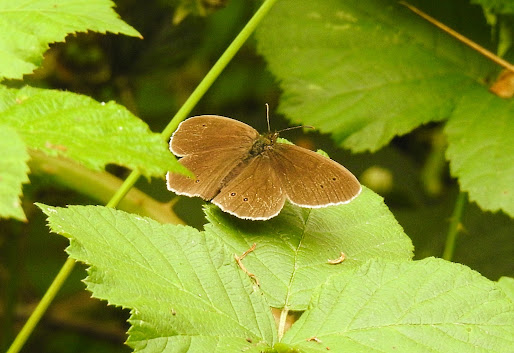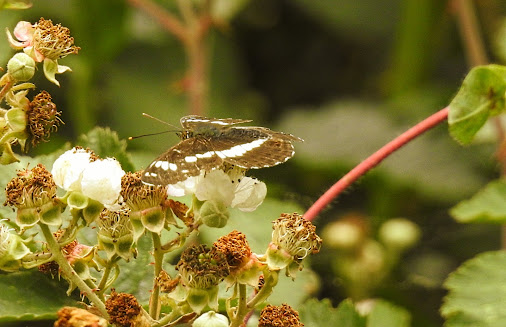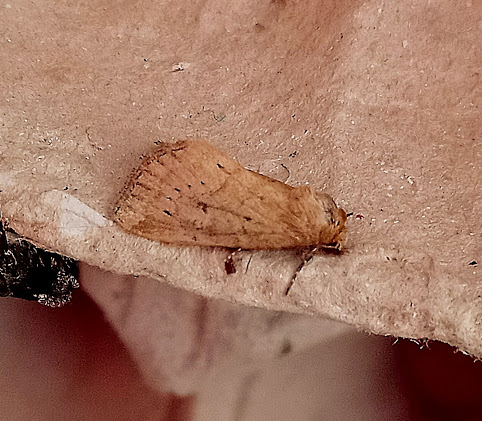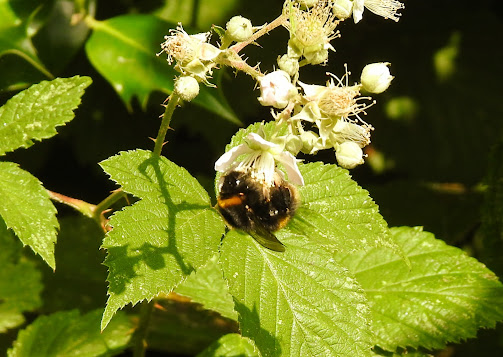Saturday 1st July 2023.
Though I never got to photograph any of the Purple Emperors within Whiteley Wood, Emma Parkes managed to grab this photo of one of them this morning.
After yesterday's sighting of a Wood Sandpiper at Blashford Lakes yesterday, I was hoping the same bird would still be present there today; but sadly it wasn't reported. Therefore, my next plan would be to Whiteley Woods on the back of the advice from fellow birder, Emma Parkes, in locating my first sighting of a Purple Emperor butterfly. It is a species of UK butterfly that has eluded me for a long time and finally, I actually caught up with some.
Above, one of 7 Uncertain moths present by Andy's moth box this morning and below, this Inlaid Grass-veneer (Crambus pescuella) was on the wall beside the back door.
Though I never put my moth box on overnight due to overnight rain coming in here on the south coast. However, Andy FIsher had his moth box on overnight in his Cowplain garden and although there was nothing new for the year, he still had a reasonable variety of moths on show within his egg trays. The following moths were present this morning:
- 7 Uncertain
- 4 Heart & Dart
- 5 Willow Beauty
- 3 Riband Wave
- 1 Double-striped Pug
- 4 Box Tree Moth
- 1 Codling Moth
- 3 Garden Grass-veneer
- 4 Rosy Tabby
- 1 Inlaid Grass-veneer
Heads up! Myself, Andy and Geoff keeping an eye on the treetops for the star butterfly. Below, another start attraction here was the Purple Hairstreaks, including this individual that was also photographed by Emma Parkes.
After picking up Geoff Farwell, we made our way to Whiteley. I have never been along the track through Whiteley Woods and so a new location that will be used again and again in the following years as we came across a total of 18 species of Butterfly today that included the superb Purple Emperor. Unfortunately, this species remained quite high in the tree tops, favouring the Oak trees near the main footpath. Emma and Matt Parked came along in the morning also and managed to grab a nice photo of one of the insects (see photo). Both Purple Hairstreak (a Lifer for Andy) and White Admirals were seen in good numbers as were Ringlets, which were our first of the year.
Above, Small Skippers were abundant as was, below, Ringlets.
It was rather damp along the footpath after we had parked the car, but though it was still a bit overcast, there were good numbers of Meadow Browns seen along the bridle path. Both Small and Large Skippers were abundant low down in the grass and also the flower laden brambles and we even found a few Silver Y moths and the micro moths, Variegated Fruit-tree Tortrix and an Italian Tubic (Metalampra italica). Geoff spotted a ‘teneral’ type of Damselfly of which I eventually got it identified as a female Common Blue Damselfly by the experts on the Facebook group UK Dragonflies and Damselflies.
Above, Gatekeepers were also abundant along the main Ride and below, I found this micro moth, Italian Tubic (Metalampra italica); a species I have had in my moth box recently.
The following species of butterfly were seen in Whiteley Woods between 8.45am till 2,30pm:
- Ringlet (NFY)
- Gatekeeper
- Meadow Brown
- White Admiral (NFY)l
- Red Admiral
- Purple Emperor (LIFER)
- Silver-washed Fritillary (NFY)
- Large White
- Small White
- Purple Hairstreak (NFY)
- Marbled White
- Brimstone
- Painted Lady (NFY)
- Comma
- Small Skipper
- Large Skipper
- Speckled Wood
- Holly Blue
Above, we found this Dark Bush-cricket by one of the footpaths and below, Marsh Thistles stood proud by the main footpaths and attracted a good number of both Bees and Butterflies.

Still on insects, we had four species of Dragonfly here today as well. A female Emperor Dragonfly was seen first flying up and down the ride we had come up from and then Geoff spotted a large Dragonfly feeding on something on the gravel track. On close inspection, it was a female Black-tailed Skimmer that was feeding on a Ringlet butterfly! We even found the remains of the wings of the poor butterfly that was being scattered about by the wind. Andy found another Dragonfly while laying down on the ground as a female Broad-bodied Chaser came in to land on the brambles at the T-junction between the ride and the gravel track. Our final Dragonfly was a real beauty, a Golden-ringed Dragonfly. I have not seen one for a few years and so was made up when Geoff spotted it perched on a Silver Birch tree. Just a shame I never was able to grab a photo of this stunning insect.
Above, a Comma butterfly resting on the footpath and below, a male Common Carder Bee.
Earlier, Emma told us where to look for more Purple Haristreaks near a small pond and while checking out the Pond on the return leg, we found Common Blue, Blue-tailed and Large Red Damselflies resting and flying around the reeds. While studying the Damselflies, I found quite a few Brown China Mark moths, which being a day-flying moth, showed very well for us at this lovely location. Another good moth to be added to my year list.
Above, the only Speckled Wood butterfly seen today and below, this Ride was full of butterflies and insects.
Even Grasshoppers and Crickets got into the act with sightings of both Dark Bush Cricket and Roesel’s Bush Cricket seen well. Geoff spotted a Long-winged Conehead and Meadow Grasshoppers were abundant too. I believe Matt Parke’s daughter, who came along with them, was fascinated by them. We did see a very unusual Bee flying near where we stood, but it was simply too fast for me to photograph as it never settled all the time we were watching it. However, I got better luck with a smart male Common Carder Bee perched on Silver Grass.
Above, this unusual plant is called Sneezewort. Below, an unusual Roesel's Bush Cricket showing a lot of green colouration on the insect.
Some nice plants were identified by Geoff too that included Marsh Thistle, Lesser Spearwort, Sneeze Wort and Creeping Soft Grass among the both Birds-foot Trefoil and Greater Birds-foot Trefoil (the latter the taller of the two plants).
Above, Creeping Soft Grass, which was identified by Geoff and below, the cast of a Dragonfly species that has recently emerged.
But let's not forget the birds seen and heard today. We had a possible Honey Buzzard over, which sported a long tail, long thin wings, I couldn't see any breast band, small head; but it was flying into the strong wind and had the wings half closed. Though I am not going to add it to my year list, it most certainly came close. We all agreed in the end that it was a probable. We did see a couple of Common Buzzards, including one flying through the woodland. Other birds seen included good numbers of Mediterranean Gulls flying high over and there were two sightings of a Raven flying over the woodland.
Above, a Red Admiral and below, a Comma butterfly.
A Common Whitethroat was heard only, singing deep within trees as did a male Blackcap of which I saw fleetingly through the trees near the main footpath. We had lunch by a wood and whilst there, a Marsh Tit was seen as was a large flock of Titmice going through the woodland that included several Long-tailed Tits. A family party of Nuthatches also went through and a Treecreeper was heard calling, though we never got a sighting of the bird. On the way back, a male Bullfinch was actually heard singing deep within a tree by the main footpath and then I spotted it flying out and heading off deep within the woodland. Chiffchaffs were simply everywhere with many males singing and holding territory at various areas of the woodland.
Above, one of many White Admirals seen today and below, one of many Brown China Marks moths seen by the small Pond.
Above, another Ringlet butterfly and below, my poor photo of a Purple Hairstreak.
The day really belonged to the Butterflies and to see my first Purple Emperor was superb, though it was a shame they remained high in the canopy of the trees. They have a distinct flight pattern which I would describe as ‘Bat-like’ with lots of gliding and flapping. Andy was so chuffed with seeing so many butterfly species (two Lifers for him today that included both the Emperors and the Purple Hairstreaks), that after dropping him off, he went to Old Winchester Hill to see another two species, a Small Tortoiseshell and a Dark Green Fritillary to make it 20 species for the day for him.
Above, the female Black-tailed Skimmer eating a hapless Ringlet butterfly on the main path and below, one of several Large Red Damselflies seen near the small Pond.
Above, the female Broad-bodied Chaser Dragonfly and below, a 'teneral' female Common Blue Damselfly.





























































